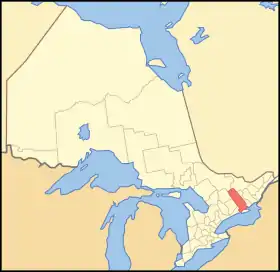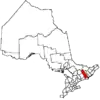Hastings County
Hastings County is located in the province of Ontario, Canada. Geographically, it is located on the border of Eastern Ontario and Central Ontario. Hastings County is the second largest county in Ontario. The county seat is Belleville, which is independent of Hastings County. Hastings County has trademarked the moniker "Cheese Capital of Canada".[2]
Hastings County | |
|---|---|
| County of Hastings | |
 Coat of arms | |
| Motto(s): Communities With Opportunities | |
 Hastings County | |
| Coordinates: 44°45′N 77°35′W | |
| Country | |
| Province | |
| County seat | Belleville |
| Municipalities | List
|
| Area | |
| • Land | 5,291.05 km2 (2,042.89 sq mi) |
| Population (2016)[1] | |
| • Total | 39,628 (excluding Belleville Quinte and Tyendinaga) |
| • Density | 7.5/km2 (19/sq mi) |
| • Population (census division) | 136,445 |
| Time zone | UTC-5 (EST) |
| • Summer (DST) | UTC-4 (EDT) |
| Website | www.hastingscounty.com |

Administrative divisions
The 14 local municipalities within Hastings County are:
- Town of Bancroft
- Town of Deseronto
- Municipality of Centre Hastings
- Municipality of Hastings Highlands
- Municipality of Tweed
- Municipality of Marmora and Lake
- Township of Carlow/Mayo
- Township of Faraday
- Township of Limerick
- Township of Madoc
- Township of Stirling-Rawdon
- Township of Tudor and Cashel
- Township of Tyendinaga
- Township of Wollaston
The Tyendinaga Mohawk Territory is within the Hastings census division but is independent of the county. The cities of Belleville and Quinte West are separated municipalities, falling within the boundaries of the county and included in the Hastings census division, but not under the administration of the county government.
History
The first boundaries of Hastings County (named for Francis Rawdon-Hastings) was organized for electoral purposes in 1792, and was described as being:
bounded on the east by the westernmost boundary of the county of Lenox, on the south by the bay of Quinte, until it meets a boundary on the easternmost line of the river Trent, thence along the river until it intersects the rear of the ninth concession, thence by a line running north sixteen degrees west until it intersects the river Ottawa or Grand river, thence descending the said river until it meets the northwesternmost boundary of the county of Addington; and the said county of Hastings to comprehend all the islands of the bay of Quinte and the river Trent nearest to the said county, in the whole or in greater part fronting the same.[3]
For the initial elections to the Legislative Assembly of Upper Canada, it was united with Northumberland County and most of Lennox County for purposes of returning one member.[4]
It was situated within the Mecklenburg District, which was later renamed the "Midland District" in 1792.[5]
In 1798, the Parliament of Upper Canada passed legislation to provide, that, at the beginning of 1800:
... the townships of Sidney, Thurlow, the tract of land occupied by the Mohawks, Huntingdon, Hungerford, and Rawdon, do constitute and form the county of Hastings.[6]
The territory withdrawn from the County continued to form part of the Midland District.[7]
In 1821, the newly surveyed townships of Elzevir, Madoc and Marmora were added to the County.[8] While in this time agriculture was the most important industry in Hastings County, by 1822 (when the Marmora Iron Works was approaching its peak production) mining was playing an increasingly more important role in the area's economy.
Prominent citizens of Hastings County and Ameliasburgh Township unsuccessfully petitioned the provincial government for district status during 1817, 1818, 1823 and 1825. After Prince Edward County successfully achieved its own government in 1831, Hastings County continued to send petitions throughout the 30s before finally achieving the status of a separate district in March 1837.[9]
It was constituted as the District of Victoria in 1839 (which continued until its dissolution in 1850).[10] By 1845, the County was declared to consist of the following townships:[11]
- Elzevir
- Grimsthorpe
- Hungerford
- Huntingdon
- Lake
- Marmora
- Madoc
- Rawdon
- Sydney
- Tudor
- Thurlow
- Tyendinaga
Belleville, after an abortive attempt two years previously, was organized as a municipality with its own Board of Police in 1836,[12][13] and was designated as the district seat in 1837.[14] It was constituted as a town under the Baldwin Act in 1850,[15] and later became a city in 1877.[16]
Edward Fidlar became the first warden of Hastings County with their first meeting on January 28, 1850. By this time the Hastings County Council was also interested in education and the building of the railroad.
On October 27, 1856 the first railroad train arrived in Belleville and by 1864 around 100 people were employed by the railroad.
In August 1866, discovery of gold at Eldorado, near Madoc, caused great excitement throughout Hastings County as people flooded to the area from all over North America. According to Barnes, "gold has been found in twenty-seven locations spread over nine townships."[17] The railroads and 170 miles (270 km) of good gravel roads opened these areas to settlement by 1880.
In 1889 the Belleville Waterworks was created as a private company, which was then bought by the city of Belleville in 1889. In 1911, Hastings County was the first in the province to appoint a reforestation committee, which was instrumental in passing laws around county forests. Postal service began in the area in 1913.[18]
By 1927 many of the original townships had been partitioned. The 1927 townships were:[19]
- Bangor
- Carlow
- Cashel
- Dungannon
- Elzevir
- Faraday
- Grimsthorpe
- Herschel
- Hungerford
- Huntingdon
- Lake
- Limerick
- Madoc
- Marmora
- Mayo
- McClure
- Monteagle
- Rawdon
- Sidney
- Thurlow
- Tudor
- Tyendinaga
- Wicklow
- Wollaston
Demographics
The figures below are for the Hastings census division, which combines Hastings County, Belleville and Quinte West, along with the Tyendinaga Mohawk Territory.
| Canada census – Hastings County community profile | |||
|---|---|---|---|
| 2016 | 2011 | 2006 | |
| Population: | 136,445 (1.1% from 2011) | 134,934 (3.4% from 2006) | 130,474 (3.6% from 2001) |
| Land area: | 6,103.48 km2 (2,356.57 sq mi) | 5,977.64 km2 (2,307.98 sq mi) | |
| Population density: | 22.1/km2 (57/sq mi) | 21.8/km2 (56/sq mi) | |
| Median age: | 42.3 (M: 41.5, F: 43.2) | ||
| Total private dwellings: | 63,014 | 60,021 | |
| Median household income: | |||
| Notes: Excludes census data for incompletely enumerated Indian reserves. – References: 2016[20] 2011[1] 2006[21] earlier[22] | |||
Historic populations:[22]
- Population in 2001: 125,915
- Population in 1996: 126,099
Transportation
The county is served by Highway 401 in the south, Highway 7, a leg of the Trans-Canada Highway, in the central region, Highways 62 and 37 travelling north to south, Highway 28 travelling east to west in the northern region, and Highway 127 travelling north from Maynooth, also in the northern region.
County Council

Following are members of Hastings County Council as of August, 2019:[23]
Warden: Rick Phillips
Town of Bancroft: Paul Jenkins
Township of Carlow/Mayo: Bonnie Adams
Municipality of Centre Hastings: Tom Deline
Town of Deseronto: Dan Johnston
Township of Faraday: Dennis Purcell
Hastings Highlands: Vic A. Bodnar
Township of Limerick: Carl Stefanski
Township of Madoc: Loyde Blackburn
Municipality of Marmora & Lake: Jan O'Neill
Township of Stirling/Rawdon: Bob Mullin
Township of Tudor & Cashel: Libby Clarke
Municipality of Tweed: Jo-Anne Albert
Township of Tyendinaga: Rick Phillips
Township of Wollaston: Barbara Shaw
Education
Currently Hastings & Prince Edward District School Board operates public schools.
Previously Hastings County Board of Education operated public schools.
Emergency Services
There are 5 EMS stations in Hastings County with Hastings-Quinte EMS HQ located in Belleville, Ontario.
See also
References
- "2011 Community Profiles". 2011 Canadian Census. Statistics Canada. July 5, 2013. Retrieved 2012-03-15.
- "Artisanal Cheese". hastingscounty.com. Retrieved 2017-12-07.
- Proclamation of July 16, 1792
- Proclamation of July 16, 1792
- An act for building a gaol and court house in every district within this province, and for altering the names of the said districts, S.U.C. 1792, c. 8, s. 3
- An act for the better division of this province, S.U.C. 1798, c. 5, s. 16
- 1798 Act, s. 18
- An Act to repeal part of an Act passed in thirty-eighth year of His late Majesty's Reign, intituled, "An act for the better division of this province," and to make further provision for the division of the same into Counties and Districts, S.U.C. 1821, c. 3, s. 5
- An Act to authorise the Erection of the County of Hastings into a Separate District, S.U.C. 1837, c. 31, s. 5
- An Act for abolishing the Territorial Division of Upper-Canada into Districts, and for providing for temporary Unions of Counties for Judicial and other purposes, and for the future dissolutions of such Unions, as the increase of wealth and population may require, S.Prov.C. 1849, c. 78, Sch. B
- An Act for better defining the limits of the Counties and Districts in Upper Canada, for erecting certain new Townships, for detaching Townships from some Counties and attaching them to others, and for other purposes relative to the division of Upper Canada into Townships, Counties and Districts, S.Prov.C. 1845, c. 7, Sch. B
- Directory 1889, p. 17.
- An Act to repeal an Act passed in the fourth year of His present Majesty's reign, entitled 'An Act to establish a Board of Police in the Town of Belleville, and to make further provisions for the establishment of a Police in said Town, S.U.C. 1836, c. 14
- 1837 Act, s. 1
- An Act to provide, by one general law, for the erection of Municipal Corporations, and the establishment of Regulations of Police, in and for the Counties, Cities, Towns, Townships and Villages in Upper-Canada, S.Prov.C 1849, c. 81, s. 201, Sch. B
- An Act for the Incorporation of the Town of Belleville as a City, and for the Consolidation of the debt thereof, S.O. 1877, c. 33
- Barnes, Michael (1995). Gold in Ontario. Erin: The Boston Mills Press. pp. 13–18. ISBN 155046146X.
- Historic Hastings by Gerald E. Boyce
- An excerpt from The Province of Ontario: A History, 1615-1927, by Middleton, J.E. & Langdon, F., 1927, Dominion Publishing Co., Toronto, made into a geo-code map copyright 2015 by Lisa Rance. Accessed 2 June 2020.
- "2016 Community Profiles". 2016 Canadian Census. Statistics Canada. February 21, 2017.
- "2006 Community Profiles". 2006 Canadian Census. Statistics Canada. March 30, 2011. Retrieved 2012-03-15.
- "2001 Community Profiles". 2001 Canadian Census. Statistics Canada. February 17, 2012.
- "Warden and Council". County of Hastings. Retrieved August 6, 2019.
Further reading
- Boyce, Gerald E. Historic Hastings - Volume One with New Introduction and Expanded Index, Global Heritage Press, Milton, 2013
- Union Publishing Company Farmer's and Business Directory for the Counties of Frontenac, Hastings, Lennox, Addington, Prince Edward for 1899, Union Publishing Company, Ingersol, 1899 (facsimile reprint by Global Heritage Press, Milton, 2010)
- Directory of the County of Hastings. Belleville: Intelligencer Printing and Publishing Co. 1889.
- Elizabeth Hancocks and W. E. Britnell Hastings County Marriage Register 1858-69, Global Heritage Press, Milton, 2005
- June Gibson, Indexed by Elizabeth Hancocks, C. G. & Shannon Hancocks Hastings and Prince Edward County - Surrogate Court Index of Ontario, Canada, 1859-1900 ( Wills)- Second Edition, Global Heritage Press, Milton, 2005
- Dan Walker and Fawne Stratford-Devai Victoria District Marriage Register 1839-1858 , Global Heritage Press, Milton, 2000
- Rolph and Clark, Brian Tackaberry Directory of the County of Hastings 1879 - 1880, Rolph and Clark, 1904 (facsimile reprint with new Introduction and new Index by Global Heritage Press, Milton, 1999)
- Pioneer life on the Bay of Quinte, including genealogies of old families and biographical sketches of representative citizens. Toronto: Rolph and Clark, Limited.
External links
| Wikimedia Commons has media related to Hastings County, Ontario. |
